INDONESIA: Stagnating Rice Production Ensures Continued Need for Imports
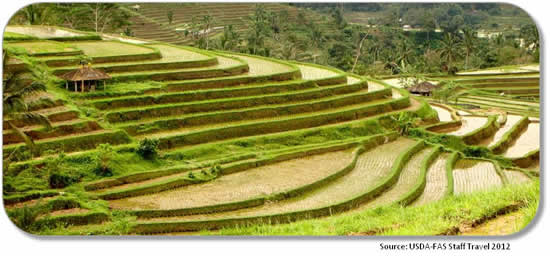
Indonesia ranks 3rd in the world in regards to total rice production, but has also been the world’s 7th largest rice importer over the past 5 years – on average requiring over 1.1 million tons of imports per year. Of the top ten global rice producing nations, only the Philippines and Indonesia also rank in the top ten of all rice importers. Owing to the perennial shortfall of rice production, food security and the pursuit of national rice self-sufficiency have become predominant concerns of the government in Indonesia. Rice is the staple foodgrain, and the country's primary statistical agency (Badan Pusat Statistik or BPS) estimates Indonesia to have the 7th highest per capita rice consumption rate in the world, at 139 kilograms per person. The Indonesian government also estimates that its people rely on rice for roughly 50 and 40 percent of their daily caloric and protein requirements, respectively. For this country of 248 million people (The World Factbook), the status of its domestic rice supply is synonymous with its food security. However, in recent years total rice consumption has been rising faster than production, as the growth rate of national rice area and yield has faltered.
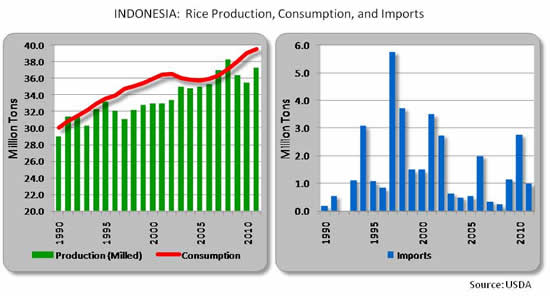
This imbalance has the potential to weigh heavily on domestic food prices and the international rice market anytime adverse weather causes significant declines in seasonal rice production. The fact that Indonesian rice production has stagnated during the past 5 years when beneficial rainfall has been the norm is a real concern. In recognition of these underlying trends, government authorities announced new program initiatives in 2011 to create a 10 million ton rice surplus (milled basis) by 2015. However, rice industry observers indicated there are no quick or easy solutions to producing increased growth rates at the farm-level today in Indonesia – and the country is likely to continue to require imports to fill the gap. Analysts from the USDA Foreign Agricultural Service (FAS) and the U.S. Embassy in Jakarta investigated the rice production environment in Indonesia and the outlook for growth in the sector during travel in the country in early 2012.
Rice Growing Environment
Indonesia is a widespread archipelago of 17,500 islands located along the equator in Southeast Asia, with a diverse tropical environment and plentiful annual precipitation. Located along the “ring of fire” the nation is home to the most active volcanic islands in the world (Java and Bali). The volcanic origin of the archipelago provided vast areas of fertile soils which support both dense tropical rainforest and agriculture. Average annual rainfall in the country is roughly 3,175 millimeters (125 inches), but can exceed 6,100 millimeters (240 inches) in the mountainous highlands. The combination of copious rainfall and fertile soils make many areas of the islands ideally suited for farming. Total agricultural land in 2010 was estimated by the Indonesian government (BPS) at roughly 40.7 million hectares, or 22 percent of the total land area in the country. The major crops produced in Indonesia include, but are not limited to, rice, palm oil, sugarcane, cassava, coconuts, corn, bananas, rubber, mangoes, oranges, chillies, sweet potatoes, soybeans, and peanuts.
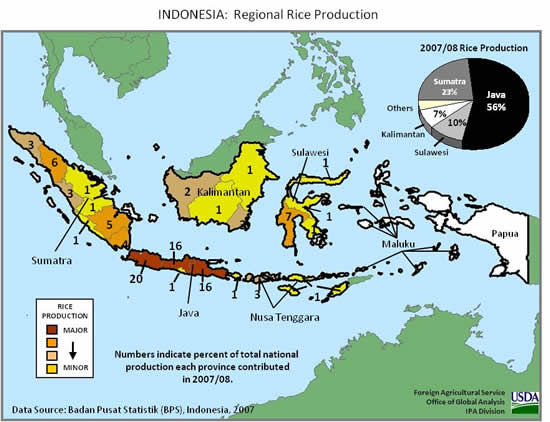
The agricultural environment in Indonesia is divided largely by geography and altitude, with intensive food crop production occurring on the inner islands (Java, Bali, Lombok and Madura) while less-intensive perennial cropping systems (estate crops of oil palm, sugar, rubber, cocoa, coffee, tea) predominate on the outer islands of Sumatra, Kalimantan Sulawesi, and Papua. Natural soil fertility is highest on the inner islands, while lower-fertility acid soils predominate on the outer islands. This is a relic of the geologic parent material for the soils and the degree of weathering they have been subject to over the millennia. IRRI scientists indicate that rice was first introduced to Indonesia in about 1500BC, and has been under continuous cultivation for the past 3,500 years. Rice is by far the most important food crop grown in the country today, with cultivated area estimated by USDA at 12.2 million hectares in 2011, accounting for 30 percent of total agricultural land. Rice is grown by approximately 77 percent of all farmers in the country (25.9 million) under predominantly subsistence conditions. The average farm size is very small at less than 1 hectare, with the majority of farmers cultivating landholdings between 0.1 - 0.5 hectares in size. Rice production is heavily concentrated on the islands of Java and Sumatra, with nearly 60 percent of total production emanating from Java alone. When crisscrossing the island of Java by car or airplane, it would be understandable to mistake it for the mythic “garden of Eden,” as it is incredibly lush and intensively cultivated – with nearly every square inch of space producing food crops of one type or another. At the same time, Java is the most densely populated island in the world and home to nearly 60 percent of the nation’s population (approximately 143.8 million). Given the highly concentrated human population, there is intense competition for land and pressure to intensify the cultivation cycle and enhance the productivity of whatever food crop is being produced. Java, therefore, is also the focus of the country’s rice research and development efforts, as agricultural scientists search for the next breakthrough in high-yielding varieties and improved farming systems.
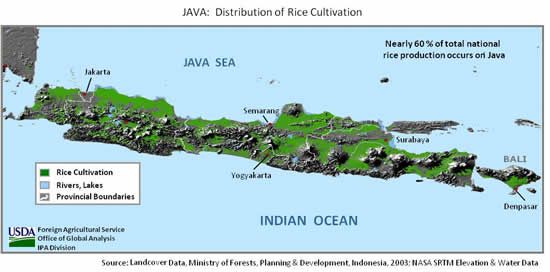
Rice is cultivated in both lowland and upland elevations throughout Indonesia, with the upland crop typically being rainfed and receiving only low levels of fertilizer applications. Irrigated lowland rice is both well watered and heavily fertilized - accounting for approximately 90 percent of total national rice area and 94 percent of total production. As a result, irrigated lowland rice yields on average are about 60 percent higher than rainfed upland crop yields. Lowland rice cultivation is heavily concentrated on Java, but is also prevalent on Sumatra and Sulawesi - the 3 islands together contributing about 89 percent of total national rice production. There is also a small amount of rice grown on the outer islands under a traditional shifting cultivation system using slash and burn techniques. This crop is usually associated with small farmers in remote areas who are establishing a mixed plantation of rubber trees and food crops. The existing forest is cut and burned, making way for rubber tree seedlings to be interplanted with upland rice and corn crops.
Irrigation
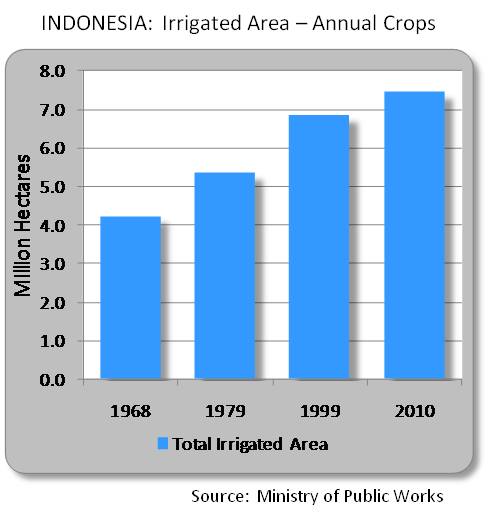
Irrigation is the foundation for stable high-yielding rice farming systems throughout the world, and Indonesia is no exception. The reliability of annual rice production is greatly enhanced through increased control over the timing and volume of water that is made available to the crop during its growing season. Farmers have engineered local systems from ancient times, diverting water from streams and rivers to nearby croplands. Governments and colonial powers began construction of larger schemes in Indonesia as early as the 18th century in an effort to increase rice production and improve domestic food and political security. However, much of this progress was lost by the 1940’s through sheer physical deterioration of systems or wartime damage caused during World War II. By the 1960’s it was reported that roughly 60 percent of the country’s irrigation systems were in disrepair. Major government programs to rehabilitate existing irrigation infrastructure and construct additional schemes began in 1969. During the following 40 year period Indonesia gradually expanded its irrigation capacity for annual crops, with total irrigated area rising approximately 3.25 million hectares or 77 percent. Total rice area in the country grew alongside the expansion in irrigation systems, increasing 4.0 million hectares or 49 percent between 1970-2011. National paddy (rough) rice production, benefiting from both enhanced irrigation supply and the widespread adoption of modern high-yielding varieties, increased 39.4 million tons or 203 percent. Milled rice production increased 24.2 million tons or 184 percent. Despite this remarkable achievement, budgets for the maintenance and repair of existing irrigation systems are perennially in short supply, ensuring continual deterioration in the national infrastructure. It is estimated that 40-50 percent of all irrigation systems nationwide are currently in disrepair, causing limitations to agriculture. In addition, the growth rate of new irrigation system development is also slowing compared to previous decades, as government budgets are largely targeted toward major crop subsidy programs for fertilizer and seed. As a result, neglected investment in irrigation infrastructure repair and development will impose serious impediments to the future potential for rice production growth in Indonesia.
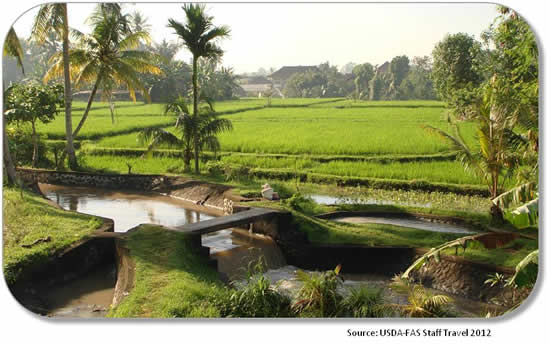
According to Indonesia’s Ministry of Public Works in 2012, approximately 84 percent of total rice area in Indonesia is irrigated, while the remaining 16 percent relies on rainfall. Rice is grown year-round, with some farmers being able to cultivate 3 crops within a given 12-month period. It is far more common for growers to cultivate 2 rice crops per year, with the typical seasonal crop cycles or rotations being rice-rice-fallow or rice-rice-secondary crops (corn, soybean, peanut). The Food and Agriculture Organization of the United Nations (FAO) estimates that approximately 70 percent of total lowland rice area produces 2 rice crops each year. About 60 percent of total rice production occurs in the first crop cultivated during the wet season (November-March), while 2 smaller harvests occur during the dry season (see crop calendar below).
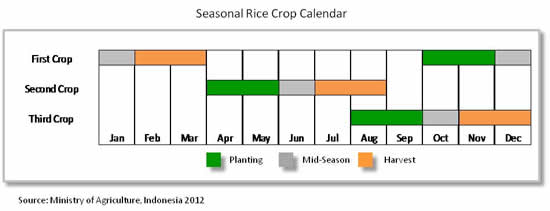
According to FAO’s AQUASTAT country database, the majority of rice sown in all 3 seasonal crops is irrigated either from large technical schemes managed by the government, regional systems managed by local governments, or community level systems operated by farmers themselves. Severe drought is not a common occurrence, but can become a major region-wide problem during strong El Nino weather events. The last severe El Nino occurred in 1997, causing crop yields to decline approximately 5 percent. Farmers typically have significant flexibility to sow crops outside the normal planting window, when short-term dryness caused by delayed onset of normal seasonal rains occur. Delayed plantings usually do not incur significant yield reductions in the rice crop, but can lead to grain quality problems when later-than-normal harvests coincide with particularly rainy weather.
Historical Rice Area and Yield
A series of very beneficial developments from 1960-2000 helped Indonesia radically increase its rice production capability during a period of very rapid population increase. These developments ensured that national rice production basically kept pace with rapidly rising domestic demand (consumption) for rice, ensuring the country’s basic food security while also reducing its requirements for imports. This prolonged period of rapid growth in both rice crop area and yield coincided with the “Green Revolution,” wherein new high-yielding cultivars were developed along with improved farming systems to significantly increase cropping intensity and yield. Indonesia’s total rice area increased roughly 5.25 million hectares or 76 percent between 1961 and 2010, primarily through gradual expansion of double and triple cropping on Java, Sumatra, and Sulawesi. The development of new irrigation schemes, including a sharp increase in the construction of major reservoirs, enabled many areas to intensify the rice cultivation cycle and harvest more than one crop per year. By 2011, more than 50 percent of total rice area is routinely cultivated during the dry season (2nd and 3rd crops), a feat which was simply impossible before these major national infrastructure developments.

Indonesia’s crop researchers also contributed to decades of rapid growth by developing and releasing 190 high-yielding (HYV) wetland and 30 high-yielding dryland or rainfed varieties since the 1960’s. Their pioneering work in isolating improved varieties enabled the country to more than double the national average rice yield by 2010, increasing it by an estimated 135 percent. Indonesian farmers have been fairly proactive in adopting new varieties, with an estimated 85 percent of all farmers cultivating HYV’s. However, it is also true that the most popular HYV rice variety sown in 2011, called IR-64, was first released in the 1960’s. IR-64 currently covers over 31 percent of total national rice area, and farmers have been cultivating and harvesting this legacy HYV cultivar for over 40 years. This demonstrates that there is significant resistance to new seed technology, with many years required to wean growers off previously adopted favorites. The second most popular variety, called Ciherang, currently covers 22 percent of total sown area and was first released in 2000. It is the first variety in decades to successfully begin to displace major crop acreage once devoted to IR-64.

Overall consumption and use of fertilizer in Indonesia also skyrocketed during this period, supporting farmer’s ability to substantially boost crop yields on fields devoted to both older traditional varieties and new HYV’s. It should be noted that it took many years for newly introduced HYV’s such as IR-64 to gain acceptance and cover substantial acreages. In the years from 1960-1980 the majority of national rice area would still have been devoted to older traditional varieties, rather than HYV’s – and the dramatic improvement in overall national yield during those 2 decades is a testament to rising fertilizer use throughout the country. Data from the International Fertilizer Industry Association (IFA) show that total national fertilizer consumption increased from 144,000 tons in 1961 to 4.47 million tons in 2009, or a 3,000 percent increase. FAO has documented that roughly 52 percent of all fertilizer consumed in Indonesia is applied to the rice crop, with the remainder utilized on the country’s corn, palm oil, vegetable and fruit crops. They also note that the strong growth in overall fertilizer consumption between 1970 and 1990 was directly fueled by government policy and programs directed towards increasing rice production. The government actively sponsored the creation of a domestic fertilizer industry to guarantee adequate supply, subsidized fertilizer costs to farmers, and developed a national crop extension service to provide outreach to growers unfamiliar with new varieties or fertilization techniques and usage. After 1990, total rates of fertilizer consumption stagnated as the government dramatically reduced both its fertilizer subsidies and rural extension services. This combination of policy and budgetary changes targeted at agriculture resulted in a protracted period of stagnating rice yields (1987-2000) and food security problems, with unusually high levels of rice imports required from 1994-2002. A shift in government policy reinstating substantial fertilizer subsidies in 2002, however, reversed the trend once again and enabled further growth in national rice yields.
Despite all the historical progress, current observers of Indonesia’s rice sector are becoming concerned by the apparent slowing of longer-term historical growth rates for both rice area and yield in the country. Crop yield growth averaged nearly 4 percent per year between 1960 and 1989, but has since slowed to about 0.5 percent per year between 1990 through 2010. Similarly, after rice area expanded at a rate of 138,000 hectares a year between 1960-1998 (2 percent growth rate), it slowed to an average rate of 9,000 hectares a year (less than 0.1 percent increase per year) between 1999-2010. Neither of these issues has easy or inexpensive solutions, but both decelerating growth trends imperil the ability of Indonesian producers to supply adequate volumes of rice to the domestic market in coming years.
Government Rice Goals and Initiatives
The Indonesian government is grappling with the issue of food security by promulgating policies it hopes will spur significant increases in food crop production and encourage greater consumption of non-rice food staples such as cassava and corn. So far, however, there is no evidence that a concrete plan of workable solutions has been developed or initiated at the provincial level, or that the population is interested in consuming significantly more cassava. The importance of these issues was apparent in a February 2012 Forum on Food Security held in Jakarta, when the President reiterated publicly that the country would continue to be vulnerable to future food crises as long as they depended too heavily on rice as the national staple food. In other words, it appears Indonesia cannot realistically attain rice self-sufficiency and it will need to diversify its diet to include non-traditional foodgrains. Unfortunately, this is signaling that the government either does not believe it can engineer sufficient growth in the rice sector, or is disinterested in allocating sufficient long-term financial resources to accomplish it.
In regards to these issues, what has the government proposed? A few of the major initiatives are outlined below.
a) Rice transmigration scheme 2009
In November 2009 the newly appointed Agriculture Minister announced that a key priority of his ministry in its first 100 days was to revive the Suharto-era transmigration scheme wherein large numbers of farmers from Java would be provided land in the outer islands to grow rice. The Agriculture Minister instructed the National Land Agency (BPN) to find ways to make as much as 6.0 million hectares of suitable land available to rice farmers. There has been no concrete plan developed or land made available as of 2012.
b) Merauke Integrated Food and Energy Estate (MIFEE) 2009
The government is targeting a remote section of the province of Papua (Merauke Regency) for major commercial-scale agricultural plantations, including rice, corn, sorghum, sugarcane, palm oil, timber, livestock, poultry, and fish. It originally proposed between 1.2 – 2.5 million hectares of land would be allocated for commercial companies to produce food and energy crops, with a minimum farm size of 12 hectares. Mechanized commercial rice farming of nearly 300,000 hectares was planned. Food commodities like rice produced in Merauke were not allowed to be exported until the government determined domestic demand had been fully satisfied. A land suitability study was completed in 2008, but as of 2010 only 500 hectares of rice farms had been developed.
c) System of Rice Intensification (SRI) expansion 2011
The Agriculture Ministry intends to increase the area under the Integrated Crop and Resource Management (ICM) program from 100,000 hectares in 2011 to 1.5 million in 2015. This implies expanding the program from an estimated 250,000 participant growers in 2011 to 3.75 million in 2015. The ICM program couples a new lower-cost rice farming system called SRI with integrated pest management (IPM) to significantly increase rice yields. Rice cultivated under SRI techniques generally uses less seed, water, and fertilizers – yet produces 20-40 percent higher average crop yields. The ICM program relies heavily on dedicated agronomic and pest-management support and education from a limited number of qualified crop extension officers. Serious problems at the farm-level have arisen in the past few years as growers attempt to adapt to this new farming technique. Difficult water and pest management issues can arise, reducing yields and eliminating the benefit of the improved system. Farmer's adoption of this technique is expected to be slower than projected, if only because the availability of qualified and knowledgeable extension staff is in such critically short supply throughout the major irrigated rice growing regions in Indonesia.
d) State-owned companies commercial rice production scheme 2012
In January 2012 the government announced plans to spend US$998 million to create 100,000 hectares of new rice fields in the province of East Kalimantan, with possible extension to 300,000 hectares if the initial project proved successful. The State Enterprises Minister reported that 3 state-owned companies currently specializing in palm oil and fertilizer production are expected to raise sufficient capital to convert the land and produce upwards of 1.0 million tons of rice by 2013, with potential to expand that to 6.0 million tons annually thereafter. This is part of the central government’s target of creating a national milled rice surplus of 10.0 million tons by 2015. The Minister further elaborated that state enterprises needed to take control of rice production because local governments on Java and Sumatra were unable and unwilling to boost their output, in part due to funding constraints. A land feasibility study has not been completed nor has any infrastructure development preceded the announcement. Without a single hectare of farmland licensed or converted to rice paddy land (most of the targeted areas are forested lands) as of March 2012, it is unlikely that 1.0 MMT of rice will be produced by 2013 – let alone anywhere near the 15.4 MMT increase required by 2014 to produce a 10.0 MMT milled rice surplus.
Conclusions
The agricultural sector in Indonesia reportedly employs over 40 percent of the national workforce while contributing approximately 17 percent of GDP. It is one of the pillars of the country’s economy. The World Bank reports that the governments agricultural spending has been increasing at approximately 11 percent per year since 2001, with its share of total government spending doubling from 3 to 6 percent by 2008. Agricultural subsidies now account for about 60 percent of the Ministry of Agriculture’s annual budget, with the fertilizer subsidy being the single largest expenditure. And yet, despite this pattern of strongly growing public sector investment or expenditure in agriculture over the past decade, most food crop yields are stagnating.
A host of serious and somewhat intractable inter-related issues are expected to limit future rice production growth rates in Indonesia, including:
- A growing population of largely uneducated poor rural farmers with low capital supply
- High population pressure on every hectare of available land in prime rice growing areas
- Limited off-farm non-agricultural employment opportunities for capital accumulation
- Declining trend in average farm size – small and getting smaller owing to traditional inheritance practices
- Annual loss of paddy land owing to land conversion to non-agricultural use (commercial, industrial, urban) is high - approximately 100,000 hectares per year
- Rice varieties from the 1960's are still dominant with 31 percent of total rice area sown to one variety, and slow uptake of new HYV’s
- Majority of government agricultural budget allocated to fertilizer and seed subsidies despite low gains in crop yields
- Critically low budget at central and provincial government levels dedicated to irrigation infrastructure development and repair
- Critically low number of highly qualified and educated crop extension and pest management officers
- Lack of performance incentives for government employees who initiate and implement major agricultural programs, including crop extension at the local and provincial level
As outlined in the article above, the combination of stagnating crop area and yields in Indonesia has the capacity to derail any hope the country has in the near future of achieving rice self-sufficiency. Population growth, estimated at 1.47 percent in 2010 (BPS), is now outpacing the growth rate of domestic rice production – inferring that the scale of annual imports will grow until the country can revive its rice sector. Area growth is hampered by historically low government investment in irrigation infrastructure rehabilitation and development, while yields are constrained by the generally slow uptake of new HYV’s and low capital availability (general impoverishment) of the average rice farm household. As in many Southeast Asian nations, the easy advances in crop production growth have already been achieved thanks largely to the introduction of improved varieties, increased fertilization, and greater access to irrigation. Reigniting growth in the Indonesian rice sector in coming years may require far greater investment, education, and development than the government has the budgetary latitude to support. In any case, the prospect of rice self-sufficiency over the coming decade seems increasingly difficult if not impossible to achieve.
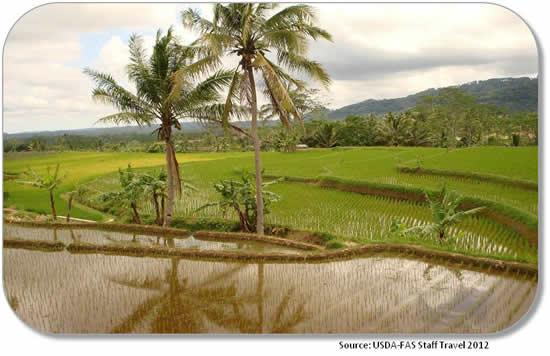
Current USDA area and production estimates for grains and other agricultural commodities are available on IPAD's Agricultural Production page or at PSD Online.
|

